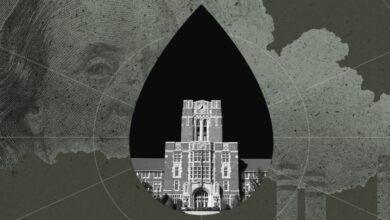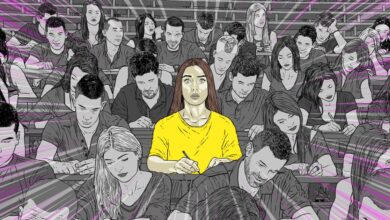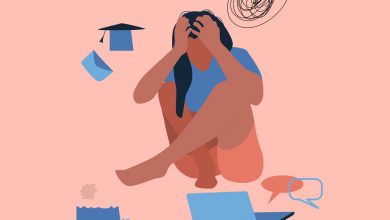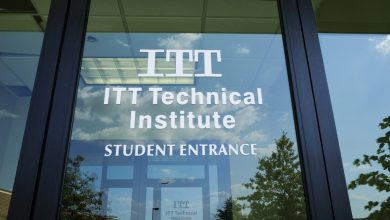A ‘Stunning’ Level of Student Disconnection
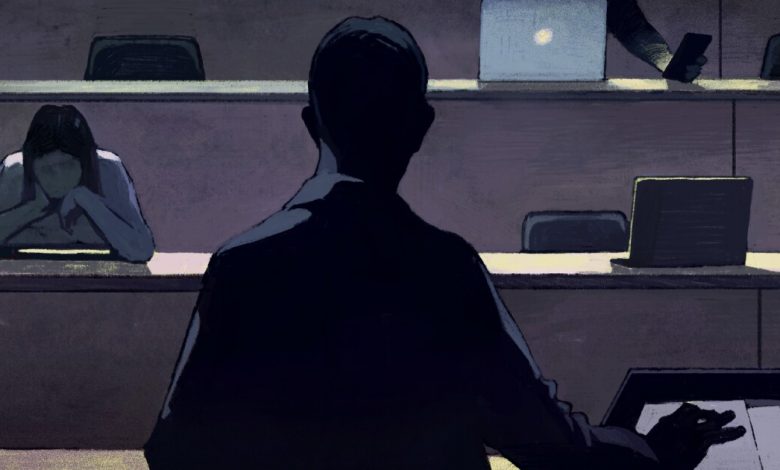
[ad_1]
“Stunning” is the word she uses to describe the level of disengagement she and her colleagues have witnessed across the Nebraska campus. “I don’t seem to be capable of motivating them to read textbooks or complete assignments,” she says of that portion of her students. “They are kind kids. They are really nice to know and talk with. I enjoy them as people.” But, she says, “I can’t figure out how to help them learn.”
Marley, a biology professor, hesitates to talk to her students about the issue, for fear of making them self-conscious, but she has a pretty good idea of what is happening. In addition to two years of shifting among online, hybrid, and in-person classes, many students have suffered deaths in their families, financial insecurity, or other pandemic-related trauma. That adds up to a lot of stress and exhaustion. In a first-year seminar last fall, Marley says, she provided mental-health counseling referrals to seven out of her 17 students.
Marley knew the pandemic was wreaking havoc on people’s lives. But she didn’t expect that its impact on learning would be so profound, even when students returned, with excitement, to campus.
She is far from alone. The Chronicle recently asked faculty members to share their experiences with student disengagement this academic year. More than 100 people wrote in to describe a disconcerting level of disconnection among students, using words like “defeated,” “exhausted,” and “overwhelmed.”
While a self-selected group, the respondents, several of whom agreed to be interviewed, represent a range of institutions: community colleges, large public universities, small private colleges, and some highly selective institutions. They described common challenges: Far fewer students show up to class. Those who do avoid speaking when possible. Many skip the readings or the homework. They have trouble remembering what they learned and struggle on tests.
The professors also described how they have tried to reach and teach students, what they think is at the root of the problem, and what’s needed to fix it. Some believe it may be necessary to change the structure of college itself.
“My students are struggling to focus within and outside of class,” wrote one history professor at a public university in Georgia, who, like many respondents, asked to remain anonymous in order to speak frankly. “They feel overwhelmed and pressed for time. They cannot separate the existential dread of Covid and now Ukraine from their daily ability to live.”
Though professors reported seeing burnout at all levels, from recent high-school graduates to adult learners, newer students seem to have struggled the most.
Freshmen and sophomores, wrote Ashley Shannon, chair of the English department at Grand Valley State University, in Michigan, are “by and large tragically underprepared to meet the challenges of university life — both academically and in terms of ‘adulting,’” such as understanding the consequences of missing a lot of class. “It’s not all their fault, by a long shot! I feel for them. But it’s a problem, and it’s going to have a significant ripple effect.”
“Students seem to have lost their sense of connection with the university and university community, and their sense of purpose in attending,” said Stephanie Masson, who teaches English at Northwestern State University, in Louisiana. After two or more years of masking, they feel as if it’s not OK to get close and talk to someone. “It’s almost like they just prefer to sit in their little cone of silence.”
Many faculty members thought this academic year, with more people vaccinated, classes meeting in person, and campus clubs and events back in full swing, would be better than last. Yes, Covid remained a significant risk, but those changes were all for the better.
But recent survey data from the Center for Collegiate Mental Health, a network of nearly 700 college and university counseling centers, jibes with what faculty members told The Chronicle. The data show that, among students who sought help, self-reported feelings of social anxiety rose significantly in the fall of 2021, with the return to campus, even as feelings of academic distress dropped. Even then, academic worries remained higher than they were before the pandemic, as did feelings of generalized anxiety, family distress, and trauma.
An increase in social anxiety could explain some of the behaviors that professors are seeing among their students, such as skipping class, said Brett E. Scofield, executive director of the center. For some students, avoidance mechanisms are their ways of coping with stress. “All those behaviors,” he said, “are very consistent with what students are reporting when they come into counseling services” — the low motivation, lack of focus, and enduring feelings of isolation.
Psychologists describe the wear and tear on the body from cumulative stress as its “allostatic load.” That may be what’s happening now, Scofield said, and it’s something that many people are going through.
I want so badly to be active in my classroom, but everything just still feels, like, fake almost.
Maci Lyman, a junior at Doane, is one of Marley’s students. She’d had one semester of a normal college experience before Covid changed everything. A first-generation student from Omaha, Lyman described the nearly five semesters since then as isolating, depressing, and unreal. When the pandemic hit, she moved in with a cousin and tried to do schoolwork from there. In the fall of 2021 she was back on campus, but all of her classes were on Zoom. Her lasting memory of that time is flipping open her laptop in the dark for morning classes, so as not to wake her roommate, then drifting in and out of sleep with it on her chest. Interactions with other people were so limited, she said, that she essentially changed from an extrovert to an introvert.
“I didn’t even realize how depressed I was,” she said of that period. “It felt normal because everyone was feeling the same way. If you walked up to someone and they were happy, it felt strange.”
This past fall, she said, she was determined to reclaim some sense of normalcy, and began getting involved in clubs and activities again. That has proved helpful. But college itself, she said, “almost felt harder.”
“There was this expectation to finally be back to normal. And you were like, Well, I don’t really know what that is,” she continued. “What is the normal college experience?”
As she returned to the classroom, Lyman found that many professors had come to rely more heavily on technology, such as asking everyone to get online to do an activity. Nor do many of her courses have group activities or discussions, which has the effect of making them still seem virtual. “I want so badly to be active in my classroom, but everything just still feels, like, fake almost.”
Lyman said Marley is one of the few professors she has who takes time to check in with students in class, and ask how they’re doing, as well as encourage them to talk even if they feel as if they don’t have much to say.
The junior often wonders how much she has changed simply because she is growing into adulthood, and how much change stems from the pandemic. “Honestly, I feel stuck,” she said. After hoping for so long that things would get back to normal, “it was so anticlimactic when you got there.”
“Really, this is it? This is what I’ve been waiting for?”
At the State University of New York at Oswego, Kristin Croyle has been studying the intertwined problem of student exhaustion, disengagement, and anxiety through surveys and conversations with faculty members, the staff, and students.
Croyle, dean of the College of Liberal Arts and Sciences, believes that the continual pivots in instruction have led students to develop habits that may no longer work now that they are back in classrooms. That feeling of ineffectualness has led to a more existential anxiety — specifically, a loss of confidence in themselves and their futures. A psychologist by training, Croyle is quick to say that those are her working theories, not hard facts. But she thinks that being a young adult today is challenging in ways that people of other ages may not understand.
“Going to college and making that investment in your future, it’s an act of hope that you can do something that is exciting and interesting to you, that you can find a career you want to engage with that will make a difference, that you can change the direction of your life with this act,” she said. But students’ hope in the future right now is low, and that kernel of enthusiasm is hard to sustain. “Our faculty are right there to hold their hand, to see what potential they have to make a difference in the world. It’s a long game; it’s not a short one. In the short run, it’s a really devastating and difficult time.”
Camryn Lloyd is a first-year student at Northwestern State and one of Ms. Masson’s students. She said she had been spared some of the worst of Covid’s college disruptions because she took a year off after high school to join the National Guard, which kept her connected with others. But she, too, finds herself thinking of the pandemic’s impact on her life — she lost an uncle — and the lives of her classmates, many of whom seem quiet and withdrawn in class. “I feel like with this generation you can’t get too happy,” she said. “There’s just a lot going on. We don’t know what to do. We’re in a state of shock.”
Many professors note that students’ feelings of exhaustion and anxiety mirror their own, and that perhaps they feed off one another. “We’re as tired and burnt out as our students are,” wrote Shannon, of Grand Valley State, “but are expected (and do genuinely try) to be accommodating and empathetic with their struggles. It’s hard to find the line between being supportive of struggling students and just giving up entirely on academic rigor.”
There’s just a lot going on. We don’t know what to do. We’re in a state of shock.
Those who teach at colleges with a high percentage of students who are lower-income, come from communities hit hard by Covid, or have work and family responsibilities say the cumulative toll of the pandemic has led to emotional overload and physical exhaustion.
“There is rarely a single issue,” wrote one faculty member. “In most cases, it is something closer to a catastrophic cascade failure. The most common components that play into this are: lack of basic needs, an economic or job-related problem, lack of child care, mental-health issues, cost of health care, and caring for a sick family member.”
Keri Brandt Off is chair of the sociology department at Fort Lewis College, in Colorado, which enrolls many Native American and Alaska Native students. This past year she has noticed an increased sense of “weightedness” among her students. They show up looking exhausted and often escape into their cellphones. “They’re here, but they’re not here,” she said. That’s not surprising, given how hard the pandemic hit Native communities. “I have students who lost many, many family members.”
Some faculty members who responded to The Chronicle believe that students’ study skills atrophied in the shift to remote learning, especially in high school. Workloads were often lighter. Deadlines became fluid. Discussion happened asynchronously or not at all. Students entered college, they believe, expecting more of the same.
“There has been a lot of concern that the use of Zoom, particularly recording and posting things later, has led students to develop the mistaken idea that they don’t need to pay attention or be engaged at the time of class because they can just go back and review the recording later,” wrote one faculty member who teaches a large introductory-biology course. “The problem is, they don’t do that.” In a class of 120, only one or two watch the recorded videos, the instructor said, and only 20 to 30 attend class.
Yet faculty members also pointed out that some of the trends they are seeing this year, including shorter attention spans and growing mental-health problems, predate the pandemic. The strains of the past two years simply accelerated those longer-term trends.
Mary Beth Leibham teaches child development and educational psychology at the University of Wisconsin at Eau Claire. She began noticing decreased engagement in her classes five or six years ago. Students say they feel overwhelmed, tired, and lost, she wrote. Leibham worries about the pressure students put on themselves “to have it all figured out.”
For many students, she said, success means getting straight A’s, always going above and beyond, and “good enough” is not really good enough. “This breaks my heart,” she wrote. “My students are so much more than their GPAs and sports accomplishments. I tell them this every chance I get, but I fear they don’t believe me.”
“Quite frankly, I’m annoyed when I see or hear faculty whining about students not showing up or not putting what the instructor thinks is 100-percent effort in,” wrote Sharon Lauricella, a professor of communication and digital-media studies at Ontario Tech University, in Canada. Her approach, she said, is to make sure that her classes are engaging, enjoyable, and essential.
Like many professors, Marley, at Doane University, decided to make building relationships in her classes a priority, as an antidote to the sense of isolation she could feel among her students. She found herself having to work harder, too, to stay positive and assume students are doing the best they can. “In the fall, when I lost that, it became a self-repeating cycle,” she said. “I was frustrated with them, and they pulled back.”
This semester, she created an anatomy-based scavenger hunt in one course, pairing students with others they had not worked with before. She also rewards students for contributing to class discussions, passing around a bowl of candy. “I talk all the time about how it’s important to try,” she said. Allison Skala, another of her students, said that approach makes a difference: “Her setting that as the tone in her class has been so motivating. I look forward to going to class because I know my words are going to be taken into consideration.”
Incorporating field trips, podcasts, “real world” assignments ― and shorter lectures ― are increasingly popular. The more that an assignment, or a course, connects to students’ lives, professors said, the more likely they are to be engaged.
Marley found that to be true in a class about opioids and addiction that she team-teaches with an English professor. Even though a significant percentage of students still don’t complete the assignments, they are much more engaged over all. “For a large number of students, they have a family member with an addiction,” she said. And compared with, say, an introductory-biology class, this one “speaks much more directly with what’s happening in their lives.”
Even before Covid hit, Brandt Off, the Fort Lewis sociology professor, had been wrestling with how to address the increase in anxiety and depression she noticed among her students, which sometimes manifested itself in addiction or suicide attempts. She is reminded regularly that even if students aren’t showing up, they still have something to say.
“The work they are doing is amazing,” she said. “They might not come to class, but they are submitting assignments that are so thoughtful and well done.” In a social-theory class that discusses dualism ― the way people present one version of themselves to the world and another in private ― she asked students to apply that concept to their own lives. They came through with powerful essays, she said.
But such strategies are far from a sure bet. And many faculty members said that nothing they do makes much of a difference with their truly disengaged students.
“I can’t seem to reach this group,” wrote a music-history professor, after describing how she uses low-stakes assignments that include detailed instructions and group work in class, intended to prepare students for an open-book take-home exam. That worked in earlier years, but not now. “I’m trying to be accommodating with extending deadlines, giving personal invitations to office hours and appointments, and more,” she said, “but, honestly, it’s feeling like they are just not interested in doing the work. I get it. I’m also exhausted.”
Professors are talking with colleagues in their departments and across campus ― including psychological counselors and academic advisers ― about those challenges, with mixed results. “We just get lots of contradictory top-down messaging about supporting our students,” wrote one, “but little actual guidance about how we can do so while maintaining policies.”
Others say it is helpful to discuss challenges and share insights, even if solutions aren’t immediately apparent. “Once we see the patterns, we can begin to understand better what is happening,” said Brandt Off, “but I mostly feel like I am swimming through the dark as a teacher these days.”
“The short answer is, we don’t know,” said Scofield, of the Center for Collegiate Mental Health. “We’re still in a pandemic.” What is clear, he said, is that “meeting students can’t just be dealt with by one part of college. It’s a collective effort.”
Some are asking whether college itself needs to change. This is not a new conversation, of course, as it feeds into broader concerns about the value and relevance of a degree. But for some the growing feelings of anxiety and distraction among students have escalated the urgency of the question.
“People come to college because they want to be challenged,” said Andy Driska, an associate professor in the department of kinesiology at Michigan State University,
who teaches an online graduate course in exercise and sports science. Yet colleges seem hesitant to challenge students right now out of a fear that they might break. “It’s almost like we need to come together, as faculty and students. How do we hit the reset button? What does education need to look like?”
Two ideas come up most frequently in the discussions professors say they are having with one another, and in their observations of their own teaching: increasing experiential learning and redesigning courses to connect more closely to students’ lived experiences and prospective careers.
Experiential learning, in which students learn by doing, addresses many of the shortcomings of traditional higher education, its proponents say. It connects learning to the world off campus, and it provides a sense of immediacy that lectures, problem sets, and textbooks often cannot. Would it be better, Driska asked, if 18- to 20-year-olds were encouraged to do two years of national service? “I feel like we’re at that point,” he said. “All reform effects are still just kind of pecking around the edges. We’re not talking about big, systematic things to change and rethink education.”
Laura Niesen de Abruna is provost of York College of Pennsylvania. She has been closely tracking how remote learning has shaped students. Students wanted to return, she said, but they wanted to come back to residence halls, sports, clubs, and conversations with professors. “What they don’t want is to sit passively. It reminds them of what they went through with the great pandemic.”
A former president of the Association of Chief Academic Officers, Niesen de Abruna said the time had come to reinvent the academic experience. Can professors build more hands-on learning into their courses? Are their classes and course sequences designed to help students build careers or just turn out future Ph.D.s like themselves?
“How can we change the model that we have in higher education,” she said, “from coverage of disciplines to experiential learning, which is really connected to the careers that most of our students are going to have?” The answer, she believes, can help York and other colleges engage students more effectively.
Mallory Bower, SUNY-Oswego’s coordinator of first-year experiential courses and engaged learning, has also been thinking about the future of learning. While today’s students are prone to anxiety, she noted, they are also adept at exploring and learning through the internet. “Students can feel like, If I can find this on YouTube, then why am I here?” she said. “They are looking for a return on investment, and I don’t blame them at all.”
Bower incorporates experiential learning in all of her courses, which cover a range of topics, including strategic communications and career preparation. She also leads a first-year seminar that requires students to explore the campus.
Last year she created a course called “Who Do You Think You Are?” It was a success, she said, because students were encouraged to have serious conversations on complicated topics, like abortion laws, race, or sexuality. It also gave them a sense of agency by, for example, devoting class time to discussing how to write to their legislator or register to vote.
Bower acknowledged that professors like her have more leeway than, say, those who teach content-heavy science courses. But she hopes that her classes will provide students with a sense of purpose that will carry over into other parts of their lives. “We can’t do everything,” she said. “We can’t fix everything. But we can do little things.”
Creating that sense of connection, to help students see the larger purpose and value of higher education, may be what helps them regain their footing.
[ad_2]
Source link


